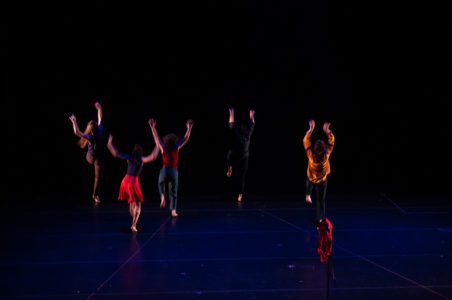By Emma Friedlander
friedlan@grinnell.edu
This weekend’s dance ensemble performance, “Stranger in a Strange Land,” incorporates so much more than simple dance. The piece is a multimedia, musical and movement showcase, bringing our understanding of what a dance performance can entail to new heights.
“Stranger in a Strange Land” is a triptych, meaning that it features three separate pieces that come together to constitute one big performance. The three pieces are choreographed by Professor Celeste Miller, theater and dance, guest choreographer Mersiha Mesihovic and student choreographer Niya Weedon ’18. Each choreographer crafted their piece by responding to one prompt from Miller: What does it mean to be a stranger in a strange land?
“It seems like we are such a divided nation right now,” Miller explained. “All of us at some point in our life have been felt like a stranger in a strange land. For some of us it’s more intense and it’s an everyday experience, and for others it might be as simple as you’re invited to a party and you didn’t realize it was formal and you showed up in jeans.”
The first part of the triptych, “Stranger Things: An Immigrant Story You Do Not See On TV!,” was choreographed by Mesihovic, a visiting choreographer from New York. She responded to the prompt by considering her own background as a refugee from Bosnia. The soundscape interchanges from music to spoken word audio to complete silence, interrupted only by the sound of high heels clacking on the stage or a dancer rolling on the floor. The performance features a voice-over recording by Mesihovic about being a refugee. In an especially intense moment of that monologue, she speaks about her grandfather’s death as he went out to buy an orange, his favorite fruit — and dozens of oranges then spill onto and off of the stage.
The second piece, “Wake-Up,” is the creation of Niya Weedon ’18. Weedon is a theatre and dance major who only changed her major from political science this year, after a year off campus at New York’s Trinity/La MaMa Performing Arts Semester. The resulting difficulties with her course load kept Weedon from accomplishing a dance MAP, but she was still eager to put on a big final production before her graduation.
“Wake-Up” is an exploration of the Black experience at Grinnell College. Weedon invited several students who do not otherwise dance to partake in the performance, ensuring an all-Black ensemble of ten students.
“I was really interested in connecting to the history of Blackness on this campus,” Weedon explained. “When it comes to the performance space, there’s not that much opportunity to have diversity exist. … I’m in the awe of the fact that I got this far and that I have ten Black people on stage performing in a mainstage. I don’t really know if it’s been done before.”
“Wake-Up” also features a combination of dance and multimedia with music and spoken word. A major feature of the piece is the projection of images from social media onto the dancers’ backdrop, including screenshots of racist exchanges on Yik Yak from 2015.
“The only people that were here to witness [the Yik Yak incidents] were the juniors and seniors. At this College, a lot of people don’t even know that it happened,” Weedon said. “I want people to leave thinking. I’d hate for somebody to come and be like, ‘Okay, some Black students did another performance about Blackness.’ We’re always trying to say something because it’s always important for us to be heard in some way.”
The finale to the triptych is Miller’s “Searching for the Eulipions.” Like the other two pieces, “Searching for the Eulipions” also features a heavy mixture of dance and movement with text, projections, props and — unique to them — a live jazz band. The piece begins with an aggressive game of musical chairs among the performers, who gradually grow integrated with a jazz band on stage and find innovative ways to share the chairs and share space with one another. The collaboration between dance ensemble and the jazz ensemble is the result of two to three years of communication between Miller and Professor Mark Laver, the director of jazz ensemble.
“These two really came together on a blank canvas. That in itself is meta-meta, that the dancers and the musicians and the choreographer and the jazz ensemble director are creating a collaboration from two groups that usually don’t usually get to move together on stage,” Miller said.
While “Stranger in a Strange Land” incorporates so many different elements of the arts, it remains rooted in the unique abilities for expression that dance offers.
“Dance as an art form has the potential to bring issues to our hearts, minds and souls that’s unique to the form because it’s about bodies,” Miller said. “To embody ideas is to look at the body as a source for discovering action.”
“Stranger in a Strange Land” began its run on Thursday night and will continue throughout the weekend, with performances on Friday, April 27 and Saturday, April 28 at 7:30 p.m. and on Sunday, April 29 at 2 p.m., all in Roberts Theater.





























































